Adrian Chong
Enhancing personalised thermal comfort models with Active Learning for improved HVAC controls
Sep 16, 2023Abstract:Developing personalised thermal comfort models to inform occupant-centric controls (OCC) in buildings requires collecting large amounts of real-time occupant preference data. This process can be highly intrusive and labour-intensive for large-scale implementations, limiting the practicality of real-world OCC implementations. To address this issue, this study proposes a thermal preference-based HVAC control framework enhanced with Active Learning (AL) to address the data challenges related to real-world implementations of such OCC systems. The proposed AL approach proactively identifies the most informative thermal conditions for human annotation and iteratively updates a supervised thermal comfort model. The resulting model is subsequently used to predict the occupants' thermal preferences under different thermal conditions, which are integrated into the building's HVAC controls. The feasibility of our proposed AL-enabled OCC was demonstrated in an EnergyPlus simulation of a real-world testbed supplemented with the thermal preference data of 58 study occupants. The preliminary results indicated a significant reduction in overall labelling effort (i.e., 31.0%) between our AL-enabled OCC and conventional OCC while still achieving a slight increase in energy savings (i.e., 1.3%) and thermal satisfaction levels above 98%. This result demonstrates the potential for deploying such systems in future real-world implementations, enabling personalised comfort and energy-efficient building operations.
District-scale surface temperatures generated from high-resolution longitudinal thermal infrared images
May 03, 2023Abstract:The paper describes a dataset that was collected by infrared thermography, which is a non-contact, non-intrusive technique to collect data and analyze the built environment in various aspects. While most studies focus on the city and building scales, the rooftop observatory provides high temporal and spatial resolution observations with dynamic interactions on the district scale. The rooftop infrared thermography observatory with a multi-modal platform that is capable of assessing a wide range of dynamic processes in urban systems was deployed in Singapore. It was placed on the top of two buildings that overlook the outdoor context of the campus of the National University of Singapore. The platform collects remote sensing data from tropical areas on a temporal scale, allowing users to determine the temperature trend of individual features such as buildings, roads, and vegetation. The dataset includes 1,365,921 thermal images collected on average at approximately 10 seconds intervals from two locations during ten months.
Machine Learning for Smart and Energy-Efficient Buildings
Nov 27, 2022Abstract:Energy consumption in buildings, both residential and commercial, accounts for approximately 40% of all energy usage in the U.S., and similar numbers are being reported from countries around the world. This significant amount of energy is used to maintain a comfortable, secure, and productive environment for the occupants. So, it is crucial that the energy consumption in buildings must be optimized, all the while maintaining satisfactory levels of occupant comfort, health, and safety. Recently, Machine Learning has been proven to be an invaluable tool in deriving important insights from data and optimizing various systems. In this work, we review the ways in which machine learning has been leveraged to make buildings smart and energy-efficient. For the convenience of readers, we provide a brief introduction of several machine learning paradigms and the components and functioning of each smart building system we cover. Finally, we discuss challenges faced while implementing machine learning algorithms in smart buildings and provide future avenues for research at the intersection of smart buildings and machine learning.
Longitudinal thermal imaging for scalable non-residential HVAC and occupant behaviour characterization
Nov 17, 2022Abstract:This work presents a study on the characterization of the air-conditioning (AC) usage pattern of non-residential buildings from thermal images collected from an urban-scale infrared (IR) observatory. To achieve this first, an image processing scheme, for cleaning and extraction of the temperature time series from the thermal images is implemented. To test the accuracy of the thermal measurements using IR camera, the extracted temperature is compared against the ground truth surface temperature measurements. It is observed that the detrended thermal measurements match well with the ground truth surface temperature measurements. Subsequently, the operational pattern of the water-cooled systems and window AC units are extracted from the analysis of the thermal signature. It is observed that for the water-cooled system, the difference between the rate of change of the window and wall can be used to extract the operational pattern. While, in the case of the window AC units, wavelet transform of the AC unit temperature is used to extract the frequency and time domain information of the AC unit operation. The results of the analysis are compared against the indoor temperature sensors installed in the office spaces of the building. It is realized that the accuracy in the prediction of the operational pattern is highest between 8 pm to 10 am, and it reduces during the day because of solar radiation and high daytime temperature. Subsequently, a characterization study is conducted for eight window/split AC units from the thermal image collected during the nighttime. This forms one of the first studies on the operational behavior of HVAC systems for non-residential buildings using the longitudinal thermal imaging technique. The output from this study can be used to better understand the operational and occupant behavior, without requiring to deploy a large array of sensors in the building space.
Personal thermal comfort models using digital twins: Preference prediction with BIM-extracted spatial-temporal proximity data from Build2Vec
Oct 30, 2021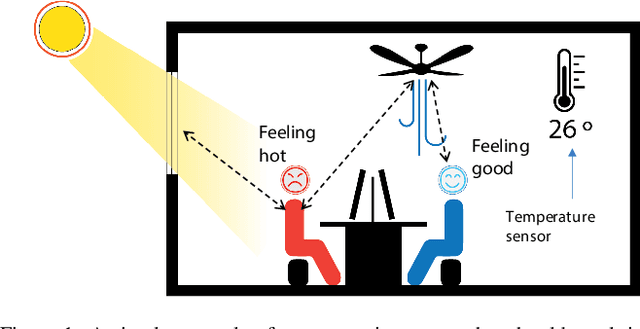
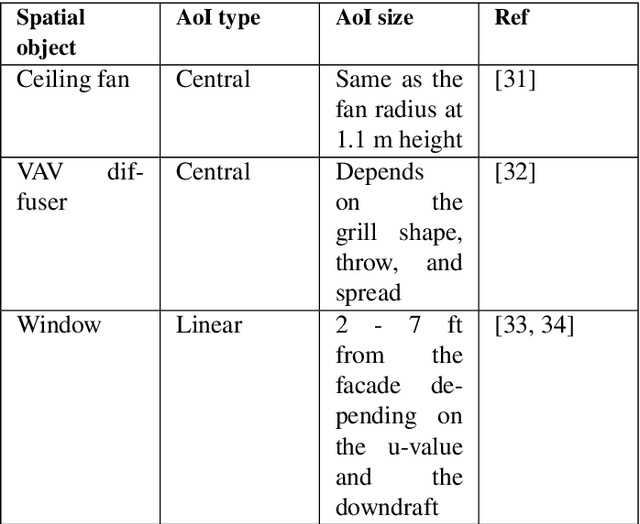
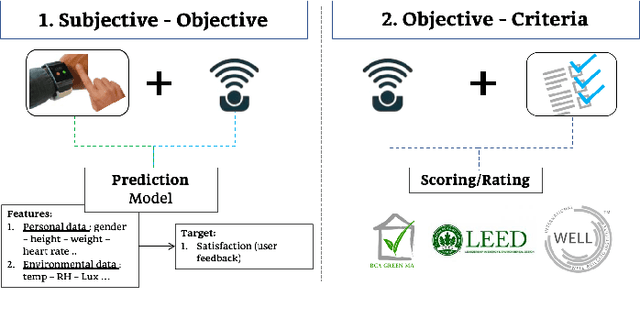
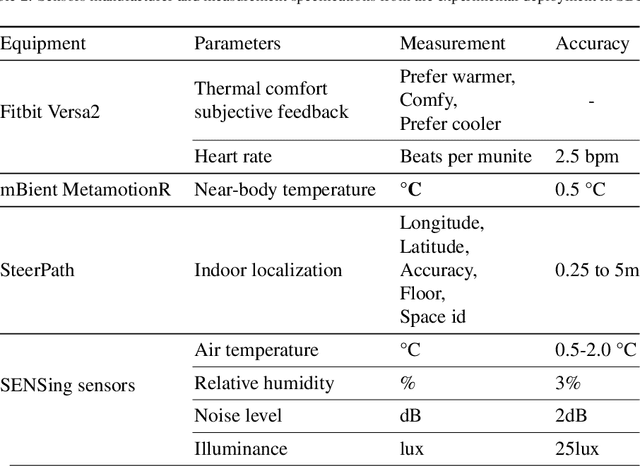
Abstract:Conventional thermal preference prediction in buildings has limitations due to the difficulty in capturing all environmental and personal factors. New model features can improve the ability of a machine learning model to classify a person's thermal preference. The spatial context of a building can provide information to models about the windows, walls, heating and cooling sources, air diffusers, and other factors that create micro-environments that influence thermal comfort. Due to spatial heterogeneity, it is impractical to position sensors at a high enough resolution to capture all conditions. This research aims to build upon an existing vector-based spatial model, called Build2Vec, for predicting spatial-temporal occupants' indoor environmental preferences. Build2Vec utilizes the spatial data from the Building Information Model (BIM) and indoor localization in a real-world setting. This framework uses longitudinal intensive thermal comfort subjective feedback from smart watch-based ecological momentary assessments (EMA). The aggregation of these data is combined into a graph network structure (i.e., objects and relations) and used as input for a classification model to predict occupant thermal preference. The results of a test implementation show 14-28% accuracy improvement over a set of baselines that use conventional thermal preference prediction input variables.
Build2Vec: Building Representation in Vector Space
Jul 01, 2020
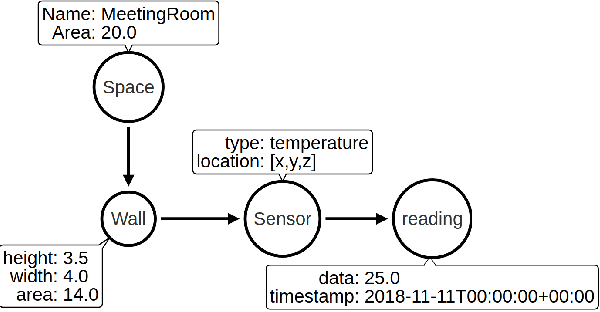


Abstract:In this paper, we represent a methodology of a graph embeddings algorithm that is used to transform labeled property graphs obtained from a Building Information Model (BIM). Industrial Foundation Classes (IFC) is a standard schema for BIM, which is utilized to convert the building data into a graph representation. We used node2Vec with biased random walks to extract semantic similarities between different building components and represent them in a multi-dimensional vector space. A case study implementation is conducted on a net-zero-energy building located at the National University of Singapore (SDE4). This approach shows promising machine learning applications in capturing the semantic relations and similarities of different building objects, more specifically, spatial and spatio-temporal data.
 Add to Chrome
Add to Chrome Add to Firefox
Add to Firefox Add to Edge
Add to Edge